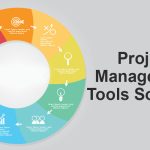Introduction
The project management triangle is used by managers to analyze or understand the difficulties that may arise due to implementing and executing a project. All projects irrespective of their size will have many constraints.
Although there are many such project constraints, these should not be barriers for successful project execution and for the effective decision making.
There are three main interdependent constraints for every project; time, cost and scope. This is also known as Project Management Triangle.
Let’s try to understand each of the element of project triangle and then how to face challenges related to each.
The Three Constraints
The three constraints in a project management triangle are time, cost and scope.

1 – Time
A project’s activities can either take shorter or longer amount of time to complete. Completion of tasks depends on a number of factors such as the number of people working on the project, experience, skills, etc.
Time is a crucial factor which is uncontrollable. On the other hand, failure to meet the deadlines in a project can create adverse effects. Most often, the main reason for organizations to fail in terms of time is due to lack of resources.
2 – Cost
It’s imperative for both the project manager and the organization to have an estimated cost when undertaking a project. Budgets will ensure that project is developed or implemented below a certain cost.
Sometimes, project managers have to allocate additional resources in order to meet the deadlines with a penalty of additional project costs.
3 – Scope
Scope looks at the outcome of the project undertaken. This consists of a list of deliverables, which need to be addressed by the project team.
A successful project manager will know to manage both the scope of the project and any change in scope which impacts time and cost.
Quality
Quality is not a part of the project management triangle, but it is the ultimate objective of every delivery. Hence, the project management triangle represents implies quality.
Many project managers are under the notion that ‘high quality comes with high cost’, which to some extent is true. By using low quality resources to accomplish project deadlines does not ensure success of the overall project.
Like with the scope, quality will also be an important deliverable for the project.
Six stages of Project Management
A project undergoes six stages during its life cycles and they are noted below:
· Project Definition – This refers to defining the objectives and the factors to be considered to make the project successful.
· Project Initiation – This refers to the resources as well as the planning before the project starts.
· Project Planning – Outlines the plan as to how the project should be executed. This is where project management triangle is essential. It looks at the time, cost and scope of the project.
· Project Execution – Undertaking work to deliver the outcome of the project.
· Project Monitoring & Control – Taking necessary measures, so that the operation of the project runs smoothly.
· Project Closure – Acceptance of the deliverables and discontinuing resources that were required to run the project.
Overcoming Challenges to Project Constraints
It is always a requirement to overcome the challenges related to the project triangle during the project execution period. Project managers need to understand that the three constraints outlined in the project management triangle can be adjusted.
The important aspect is to deal with it. The project manager needs to strike a balance between the three constraints so that quality of the project will not be compromised.
To overcome the constraints, the project managers have several methods to keep the project going. Some of these will be based on preventing stakeholders from changing the scope and maintaining limits on both financial and human resources.
A project manager’s role is evolved around responsibility. A project manager needs to supervise and control the project from the beginning to the closure.
The following factors will outline a project manager’s role:
· The project manager needs to define the project and split the tasks amongst team members. The project manager also needs to obtain key resources and build teamwork.
· The project manager needs to set the objectives required for the project and work towards meeting these objectives.
· The most important activity of a project manager is to keep stakeholders informed on the progress of the project.
· The project manager needs to asses and carefully monitor risks of the project.
Skills Required for a Project Manager
In order to overcome the challenges related to project triangle and meet the project objectives, the project manager needs to have a range of skills, which includes:
· Leadership
· Managing people
· Negotiation
· Time management
· Effective communication
· Planning
· Controlling
· Conflict resolution
· Problem solving
Conclusion
Project management is very often represented on a triangle. A successful project manager needs to keep a balance between the triple constraints so that the quality of the project or outcome is not compromised.
There are many tools and techniques that are available in order to face the challenges related to the three constraints. A good project manager will use appropriate tools in order to execute the project successfully.



Comments are closed